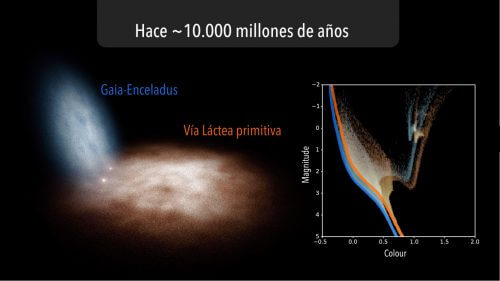A study led by researchers from the Institute of Astrophysics of the Canary Islands in Spain presents a sequence of events that gave birth to our galaxy. It was formed from the collision of two galaxies, one of which already had stars from advanced generations that contained elements heavier than helium, and the other had almost no such materials

The universe 13 billion years ago was very different from the universe we know today. Different in the sense that stars formed at a very fast rate and formed the first dwarf galaxies, whose merger gave rise to the more massive galaxies of today, including ours. However, the exact chain of events that gave birth to the Milky Way was not understood until now.
Precise measurements of the position, brightness and distance of about a million stars from our galaxy at a distance of 6,500 light-years from the Sun, obtained with the 'Gaia' space telescope, allowed the team of the Astrophysics Institute of the Canary Islands in Spain - Instituto de Astrofísica de Canarias (IAC) to reveal some of its first phases. "We analyzed the distribution of colors and sizes (brightnesses) of the stars in the Milky Way, and compared with theoretical models. We divided them into two groups according to their location. The halo that surrounds the galaxy and the galactic plane.
Explains Kerem Gallart, a researcher at the IAC and the first author of an article published in the journal Nature Astronomy.
Previous studies revealed that the galactic halo consists of two types of stars, one of which has a very high concentration of blue stars. The movement of the stars in the blue constellation allowed us to quickly identify it as the remnants of a dwarf galaxy (which we named Gaia-Enceladus) that collided with the primordial Milky Way. However, the nature of the population containing the redder stars and the question of when the merger between Gaia-Enceladus and our galaxy occurred were unknown until now.
"Analyzing the data from the European Gaia Space Telescope allowed us to calculate the age distribution of the stars in the two groups and showed that both are composed of stars even older than those in the galactic disk," says Chris Brooke, a researcher at the IAC and co-author of the paper. But if both elements were created at the same time, what distinguishes them from each other? "The last piece of the puzzle was solved by calculating the amount of "metals" (all elements other than hydrogen or helium) in the stars of both groups," explains Thomas Ruiz Lara, an IAC researcher and one of the authors of the article. "The stars in the blue group contain a smaller amount of metals than those in the red group." These findings, plus simulation predictions that are also analyzed in the article, allowed the researchers to complete the course of the history of the formation of the Milky Way.
13 billion years ago, two different galaxies began to form and merged shortly after. One was a dwarf galaxy we call Gaia Enceladus, and the other was the galaxy that formed the nucleus of our Milky Way. Then there was a flurry of new star formation, which ended 6 billion years ago, when the gas converged on the galactic plane, creating what we know as the "thin disk".
"Until now, all cosmological predictions and observations of distant spiral galaxies similar to the Milky Way indicate that this violent phase of mergers between smaller galaxies was very frequent," explains Matteo Monelli, researcher at the IAC and co-author of the paper. We have now been able to identify the specific details of the process in our galaxy, revealing the first stages of our cosmic history in unprecedented detail.
More of the topic in Hayadan:
The Milky Way is more massive, spins faster and is more likely to collide with Andromeda
The Milky Way as never seen before
The study of globular cluster stars will help solve the question of the age of the Milky Way

6 תגובות
Dear Anonymous
When someone writes in the margin of an article about astrophysics: "Those who study more discover the wonders of the Creator" or "May they discover everything that the Sages wrote" - then he is the one who stirs a banana on the table and should not complain about others.
Maor
Dear men
What you are saying here brother is due to lack of familiarity with the religious view
And what is the essence of the Torah.
The comparison between scientific facts and the Torah in these aspects is like making a difference
The comparison between a banana and a table
They have nothing to do with each other and they talk about different topics.
The Torah is the existence of one Creator, values, morals, the purpose of life, etc.
Whereas the purpose of science is research to satisfy human curiosity and improve our reality.
A company they wrote in SD...
What do you and science exactly?
I love this kind of work by scientists who show pictures and formulas and no one can verify it and very few even care if it's true.
On the other hand, they received a bundle of money.
BSD
The more researchers discover the wonders of the Creator
In this they will discover everything that the Sages said about the stars, apparently they are very close.